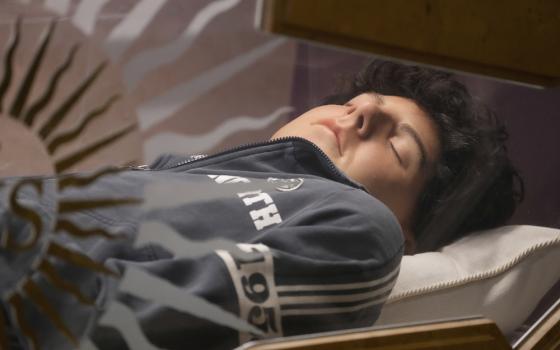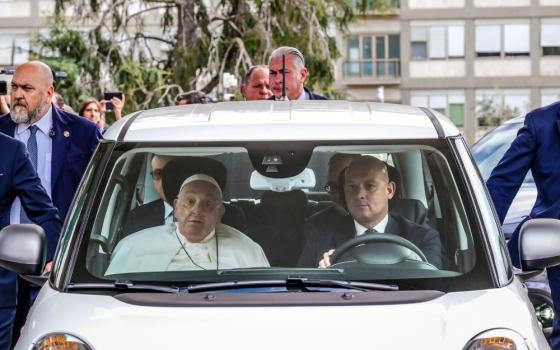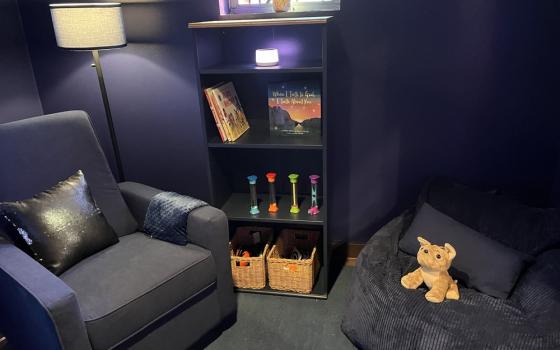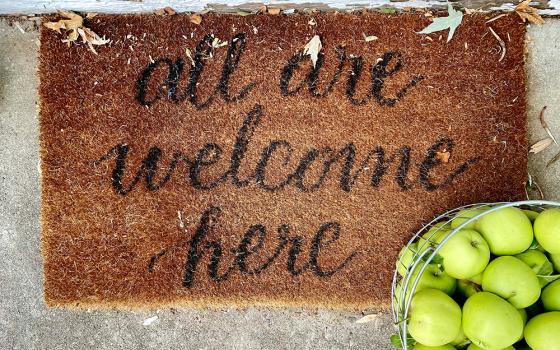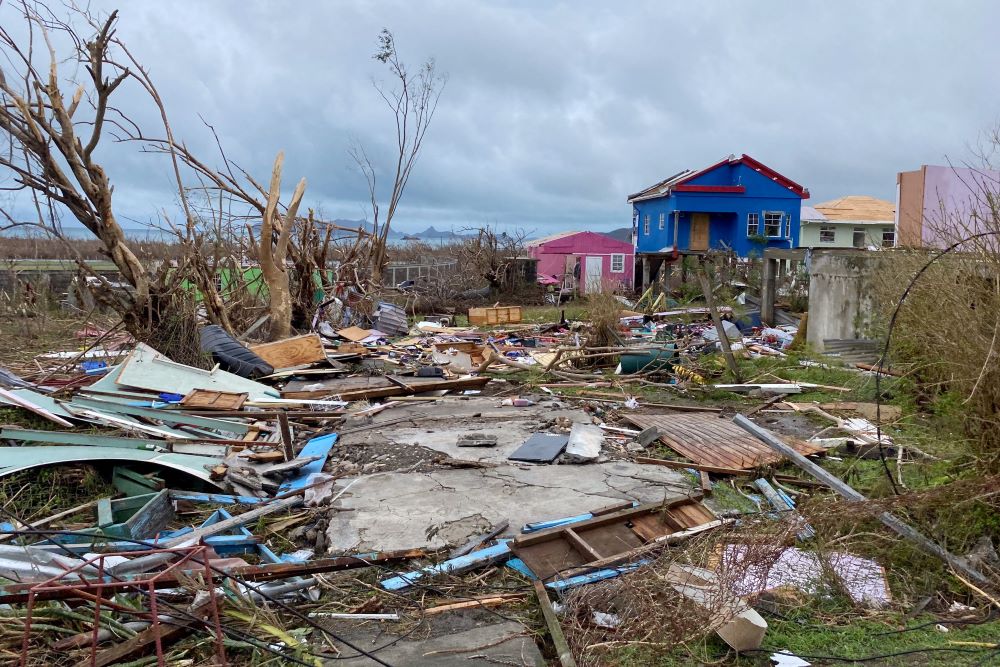
Debris lies around the foundation of a destroyed house on the island of Carriacou, Grenada, July 3, after Hurricane Beryl. Bishop Clyde Harvey of St. George's in Grenada traveled by boat to visit the island of Carriacou July 12. (OSV News/Reuters/Arthur Daniel)
Bishop Clyde Harvey of St. George's in Grenada arrived by boat to the island of Carriacou July 12 to find a traumatized community and at least two diocesan churches that suffered catastrophic hurricane damage.
On July 1, the Category 4 Hurricane Beryl landed a severe blow to the two islands of Carriacou and Petite Martinique, which are part of Grenada and situated near the northern coast of South America.
Other islands, including Jamaica and the Cayman islands along with Mexico and parts of the mainland U.S., also suffered significant damages and flooding following Beryl. Beryl was the second named storm of the 2024 hurricane season and noted for its intense strength coming so early in hurricane season.
"On Friday I went to Carriacou and it rained and rained and rained — Carriacou is normally a place lacking rain, but people had buckets sitting out and full of water," the Trinidad-born Harvey said by phone July 15. He traveled there with an Irish missionary priest who had previously served in Carriacou and who was familiar with the communities.
"We also have had a priest on Carriacou as a permanent (presence) and I wasn't feeling too badly about the time it took for me to get there, but I didn't appreciate the seriousness of the damages there until I arrived," the bishop added.
He said the diocesan Our Lady of the Rosary Church in L'Esterre was destroyed. With only one sanctuary wall remaining, it will need to be completely rebuilt from the ground up.
Another, Church of St. Patrick in Hillsborough on Carriacou, had only lost its roofing but would need to be assessed to determine if the remaining walls can serve as a future church there or will need to be replaced.
"Our Lady of the Rosary Church had been completely flattened — it is a beautiful community and has one of the best choirs on the island. The only thing left standing was a sanctuary wall with the crucifix and the tabernacle still standing. That church will have to be rebuilt completely from scratch," the bishop told the Florida Catholic, the news outlet of the Archdiocese of Miami.
Advertisement
Other diocesan teams have already made visitations and humanitarian trips to northern Grenada and Petite Martinique, where at least one church reportedly lost part of its roof and suffered other structural damage, he added.
Harvey praised the early post-hurricane outreach of Catholic Relief Services, Caritas Antilles and the local Youth Emergency Action Committee, or YEAC, which is associated with the Antilles Episcopal Conference geared at engaging Carribean Catholic youth to respond locally in times of emergency and following hurricanes especially.
YEAC teams have been credited with reaching Carriacou within a few days of Hurricane Beryl and setting up a presence there to assist with emergency response, the bishop said.
"We have been asking how do we get our young people involved, and although fledging it has tremendous potential and a form of youth ministry," he said.
"The focus of this ministry is helping them develop their own talents and using those talents in emergency assistance in times of crisis. They went out to Carriacou , set up a camp there with help from CRS and did some initial assessments and reported what was needed."
In addition, a number of Catholic schools and churches throughout the region served and are still serving as shelters while cleanup and recovery efforts continue. One government report from Grenada notes that approximately 3,500 households have been affected in St. Vincent and the Grenadines, with approximately 10,000 people living with significant damage to homes there.
And the storm's personal impact on local health care staff impedes operations throughout the health network. There are now 1,099 people in shelters in 49 shelters in St. Vincent and the Grenadines, according to one estimate.
According to a July 11 online news report from Trinidad and Tobago Weather Center, Beryl's onslaught claimed the lives of at least 33 people across the Caribbean.
The fact that Hurricane Beryl arrived so early in the season meant that the local Caritas preparations were not as complete as they might otherwise have been, Harvey said. Emergency warehouse supplies and provisions were not as robust as they would normally be in September and October, he said, but he was grateful for the aid that has come though the region already during the past two weeks.
"One of the major challenges now is how do we help with the rebuilding program but also with rebuilding lives — the real rebuilding is rebuilding people's lives," he said.
"A lot of houses were rebuilt after Hurricane Ivan (2004), but people approached Beryl but with their lives still traumatized by Ivan," Harvey said.
He is particularly concerned about the welfare of senior citizens and children in his diocese following Beryl and noted that some elderly have already been relocated from Carriacou to mainland Grenada.
Catholic schools in the area, the bishop added, fared fairly well structurally, he noted, and some were continuing to serve as hurricane shelters -- a fact that will likely have later consequences as the summer moves into the start of a new school year. One of the government schools in Carriacou was completely destroyed, he noted.
To assist with mental health needs, a team of counselors associated with the Franciscan Institute in the Caribbean made several visits to hard hit areas and were looking at ways to support long term psycho-social support for those regions.
"I had a meeting with them yesterday after three of them went out to Carriacou and we talked about what we can do best. That (project) needs funding because you have to bring (staff) in and out, and we have to consider whether we let people stay in Carriacou or do we transport them out (as needed)."
In addition, the bishop worried about the livelihoods of small farmers and small businesses that eke out a modest living in places such as Carriacou and Petite Martinique. Meanwhile, the bishop has been hosting weekly media broadcasts through the diocese's Good News Catholic Communications program seen on social media platforms to build awareness and set a spiritual tone following Beryl.
And, Harvey said, with so much attention given to the U.S. presidential election cycle, he can't help but wonder if only a fraction of the individual political contributions were redirected to humanitarian and Christian projects.
In particular, he said, the Caribbean is in dire need of support for Catholic education. "I have a tremendous challenge with Catholic schools (in terms of funding)," the bishop noted, adding that he hopes to develop future partnerships toward rebuilding Catholic education in the Antilles.
